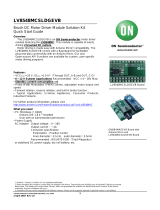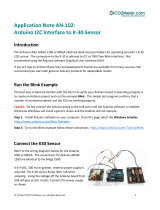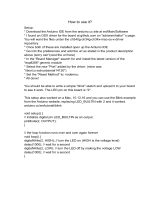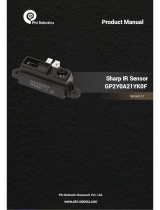Broadcom CSM-MTD Current-Sensor-Module Demonstration Kit for Automotive Motor Drive Applications User guide
- Type
- User guide

User Guide
Broadcom CSM-MTD-UG100
May 16, 2019
Overview
The Current-Sensor-Module Demonstration Kit (CSM-MTD) is designed to evaluate digital filters and isolated Sigma-Delta
Modulators with input voltage from an external shunt resistor and then output ADC data to a user's controller MCU, DSP, or
microprocessor. The kit can demonstrate sensing for an electric motor 3-phase current.
The Demonstration Kit mainly consists of the following items:
3-channel isolated Sigma-Delta Modulator Board with ACPL-C799T
Digital Filter Board with ASIC ACPL-0873T for 3-channel SDM input
Broadcom Bridge Board to Arduino Due Evaluation Board
The key features of the Demonstration Kit are as follows:
Three Individual Digital Filters in the ACPL-0873T
Sampling Time Synchronization
Fast Over-range Detection
Offset Calibration
Programmable Input Configuration
SPI Interface ADC Data Output
Sensing range up to 500A current together with a 0.1 mΩ shunt, or a sensing range of up to 1000A current together with
a 0.05 mΩ shunt
CSM-MTD
Current-Sensor-Module Demonstration Kit for
Automotive Motor Drive Applications

Broadcom CSM-MTD-UG100
2
CSM-MTD User Guide Current-Sensor-Module Demonstration Kit for Automotive Motor Drive Applications
Ordering Information
The ordering code is W1202-475318 (CSM-MTD). Contact Broadcom sales or an authorized distributor for prices.
NOTE: Broadcom does not provide shunt products, but may offer shunt samples to customers by request until the limited
stock is finished
Demonstration Kit Connections
Refer to Evaluation Board Circuit Schematic for a detailed schematic.
Connection Map between the Digital Filter Board and the SDM Board Using an FPC
Cable
FPC Connector
Same-side-contacts and 1-mm pitch Flexible-Printed-Circuit (FPC) cables are used to connect the Digital Filter Board and
the Sigma-Delta Modulator Board. Lift the connector's actuator up before inserting or removing the cable. Press down on
the actuator after inserting the cable into the connector.
Signal
SDM Board Digital Filter
H5 H1/H2/H3
VDD
41
MCLK
32
MDAT
23
GND
14

Broadcom CSM-MTD-UG100
3
CSM-MTD User Guide Current-Sensor-Module Demonstration Kit for Automotive Motor Drive Applications
Connection Map between the Digital Filter Board and the CSM-DUE Bridge Board
When other MCU evaluation boards are used to replace the Arduino Due, connect the respective MCU board I/O port to
Digital Filter Board connector P2. A 3.3V power supply is required. See the following section for more information.
Power Supply VDD Requirements
Voltage: 3.3 VDC +/- 5%
Current Minimum: 10 mA for the Digital Filter Board and 40 mA for each channel SDM Board.
Signal
Digital Filter Board CSM-DUE Bridge Board
P2 P1 Pin Name Connector
/CS 1 1 D24 JP8
/INT 2 2 D26 JP8
SCLK 3 3 SCLK P1
/RST 4 4 D28 JP8
MISO 5 5 MISO JP1
OC 6 6 D27 JP8
MOSI 7 7 MOSI JP1
DR 8 8 D25 JP8
GND 11 11 GND JP10, JP1
VDD 12 12 3.3V JP10

Broadcom CSM-MTD-UG100
4
CSM-MTD User Guide Current-Sensor-Module Demonstration Kit for Automotive Motor Drive Applications
Software Installation and Operation
Installing the Arduino Due Board USB Driver
To install the Arduion Due Board USB driver, complete the following steps:
1. Install the Arduino Due board USB driver located in the Arduino IDE from https://www.arduino.cc/en/Main/Software.
More technical information about the Arduino Due board is available at
https://www.arduino.cc/en/Main/ArduinoBoardDue.
2. During Arduino IDE installation, connect the Micro-USB cable from the computer to the Arduino Due board Programming
Port.
3. After Arduino IDE installation, connect the Micro-USB cable from the computer to the Arduino Due board Native Port.
4. Verify that the driver was successfully installed on the computer by navigating to
Control Panel > Device Manager > Ports (COM & LPT).
Broadcom GUI Software Requirements
To run the Broadcom GUI, the user’s computer must meet the following requirements:
Windows OS 7.0 or later.
A display resolution of 1920 X 1080 pixels or greater.
The user must also copy the demonstration software, DigitalFilter v1.5.exe, from a CD-ROM to the computer local
drive.
NOTE: Contact Broadcom local sales for the demonstration software.

Broadcom CSM-MTD-UG100
5
CSM-MTD User Guide Current-Sensor-Module Demonstration Kit for Automotive Motor Drive Applications
Bench Verification of the GUI Software and Demonstration Kit Functions
Bench Verification
To perform bench verification, complete the following steps:
1. Connect a 1Ω-resistor as a shunt at each channel ACPL-C799T input.
2. Send a General Waveform Generator output signal to the 1Ω-resistor. The current through the three shunts will be the
same if three 1Ω-resistors are connected to the serial port.
3. Connect the computer’s USB port to the Arduino Due Board’s Native Port.
Example of Saved Log Data

Broadcom CSM-MTD-UG100
6
CSM-MTD User Guide Current-Sensor-Module Demonstration Kit for Automotive Motor Drive Applications
GUI Software Operation
To open the GUI, double click on DigitalFilter v1.5.exe. The following image shows the GUI.
To configure the GUI, complete the following steps:
1. Select the Sigma-Delta Modulator C799T mounted on the SDM Board.
2. Select the applied input channel
3. Select the Digital Filter Mode.
4. Enter the Input Offset calibration. Before clicking on CAL to capture input offset value, short the Sigma-Delta Modulator
C799T input (that is, remove the Waveform Generator source cable and use a wire to short the 1Ω resistor). The offset
value is stored in the MCU Evaluation Board’s flash memory.
5. Enable or disable the Input Offset Calibration as necessary. When Offset Calibration is enabled, the GUI software
subtracts the offset value stored in the MCU Board’s flash memory from the raw ADC value of the digital filter.
6. Enable or Disable sampling synchronization for the filters.
7. Start or stop capturing data continuously. The GUI software reconstructs the ADC data as an input voltage signal graphic
in the GUI window.
8. Save the last captured ADC data batch to the local drive. See Example of Saved Log Data for an example of the
generated data.
9. Set the Over-Range value and channel.
10. Turn the FFT display On or Off, then select the display channel.
11. Set the Zoom level for the waveforms displayed.
12. Read the single ADC output data for each channel.
13. Close the software.

Broadcom CSM-MTD-UG100
7
CSM-MTD User Guide Current-Sensor-Module Demonstration Kit for Automotive Motor Drive Applications
NOTE:
The ADC data shown in the GUI is bipolar 16 bit.
If a channel ADC output is –32768 or 32767 continuously, there may be an input open.
SPI Communication Software Implementation and Practice with the
Arduino Due Board
The Arduino Due is configured in SPI Master Mode (SPI Mode 0 MSB first). The CS Pin is used for filter conversion start.
The CS Pin is also used by SPI Chip Select to read and write registers. When CS is low, the registers on the digital filter can
be read and written without having to toggle CS. This allows the Data Ready (DR) status on the ACPL-0873T Interrupt Status
Register (0x02) to be read without restarting the filter conversion.
Sampling Methods
There are three main methods for reading data from the digital filter.
Method 1: Poll DR Status (Using a Timer)
Since the filter conversion time is known, a timer can be set to poll the DR status in Register 0x02 so that tasks can be done
in between reads. Polling of the DR status is started just before the data is ready.
Method 2: Interrupt on DR Status on INT Pin
The ACPL-0873T Interrupt Enable Register (0x03) can be configured to output the DR status to the INT Pin, and the Arduino
Due can be configured to interrupt on the INT pin H→L. The DR status is cleared when the Interrupt Status Register (0x02)
is read, so the Interrupt Status Register needs to be read after the data has been read out from the filter in order to manually
clear the DR status.
Method 3: Interrupt on DR Pin Signal
The DR pin signal is cleared automatically when CS is L→H, so the Arduino Due can be configured to interrupt on the DR
pin signal L→H instead of using the DR status through the INT pin. The data can then be read out before the filter conversion
is restarted by toggling CS, which clears the DR pin signal.
To achieve a constant sample rate, the CS pin can be toggled using either a timer or a PWM signal, but sufficient time must
be allowed so the data can be sampled before the CS pin is toggled.

Broadcom CSM-MTD-UG100
8
CSM-MTD User Guide Current-Sensor-Module Demonstration Kit for Automotive Motor Drive Applications
Flow Charts
Method 1: Polling Flow Chart
Methods 2 and 3: Interrupt Flow Chart

Broadcom CSM-MTD-UG100
9
CSM-MTD User Guide Current-Sensor-Module Demonstration Kit for Automotive Motor Drive Applications
Sample Code
Timer Setup
// Delay = rc / (MCLK / 128)
void startTimer (Tc *tc, uint32_t channel, IRQn_Type irq, uint32_t rc) {
pmc_set_writeprotect (false);
pmc_enable_periph_clk ((uint32_t) irq);
TC_Configure (tc, channel, TC_CMR_WAVE | TC_CMR_WAVSEL_UP_RC | TC_CMR_TCCLKS_TIMER_CLOCK4);
TC_SetRA (tc, channel, rc >> 1);
TC_SetRC (tc, channel, rc);
TC_Start (tc, channel);
tc->TC_CHANNEL[channel].TC_IER=TC_IER_CPCS;
tc->TC_CHANNEL[channel].TC_IDR=~TC_IER_CPCS;
NVIC_EnableIRQ(irq);
}
void stopTimer(Tc *tc, uint32_t channel, IRQn_Type irq) {
TC_Stop (tc, channel);
NVIC_DisableIRQ (irq);
}
Method 1: Poll DR Status
void setup_polling() {
// Set flags
flag = false; obuffer = buffer = 0; counter = 0;
// Start transfer
setCS(); clearCS();
// Start Poll timer
startTimer (TC1, 1, TC4_IRQn, delay_poll [filter_type]);
// Start CS Pin timer
startTimer (TC1, 0, TC3_IRQn, delay_cs [filter_type]);
// Read interrupt status register to clear DR
spiTransfer (0x92);
spiTransfer (0x00);
}
// Main Loop
if (flag)
{
// Read interrupt status register to check DR
spiTransfer (0x92);
if ((spiTransfer (0x00)) & 0x01)
{
// Read 2/2/4/6 bytes to buffer
spiRead ((uint8_t*) &spi_data [buffer] [counter], num_bytes [chan_select]);
// Increment counter and wrap when buffer full
counter = (counter + num_bytes [chan_select]) * ((counter + num_bytes [chan_select]) < buffer_size);
buffer = (buffer + (counter==0)) & 0x01;
// Clear flag
flag = false;
}
}

Broadcom CSM-MTD-UG100
10
CSM-MTD User Guide Current-Sensor-Module Demonstration Kit for Automotive Motor Drive Applications
// CS Pin Timer Handler
void TC3_Handler() {
TC_GetStatus (TC1, 0);
// Start next transfer
setCS(); clearCS();
// Restart poll timer
startTimer (TC1, 1, TC4_IRQn, delay_poll [filter_type]);
}
// Poll Timer Handler
void TC4_Handler()
{
TC_GetStatus (TC1, 1);
// Set flag
flag = true;
// Stop poll timer
stopTimer (TC1, 1, TC4_IRQn);
}
Method 2: Interrupt Using DR Status on INT Pin
void setup_int_pin() {
// Set flags
obuffer = buffer = 0; counter = 0;
// Start transfer
setCS(); clearCS();
// Set interrupt enable register DR_E
spiTransfer (0xA3);
spiTransfer (0x01);
// Read interrupt status register to clear DR
spiTransfer (0x92);
spiTransfer (0x00);
// Enable INT pin interrupt
attachInterrupt (INT_PIN, data_ready_isr, FALLING);
// Start CS Pin timer
startTimer (TC1, 0, TC3_IRQn, delay_cs [filter_type]);
}
// Data Ready ISR
void data_ready_isr() {
// Read 2/2/4/6 bytes to buffer
spiRead ((uint8_t*) &spi_data [buffer] [counter], num_bytes [chan_select]);
// Increment counter and wrap when buffer full
counter = (counter + num_bytes [chan_select]) * ((counter + num_bytes [chan_select]) < buffer_size);
buffer = (buffer + (counter==0)) & 0x01;
}
// CS Pin Timer Handler
void TC3_Handler() {
TC_GetStatus (TC1, 0);
// Start next transfer
setCS(); clearCS();
// Read interrupt status register to clear DR
spiTransfer (0x92);
spiTransfer (0x00);
}

Broadcom CSM-MTD-UG100
11
CSM-MTD User Guide Current-Sensor-Module Demonstration Kit for Automotive Motor Drive Applications
Method 3: Interrupt Using DR Pin Signal
void setup_dr_pin() {
// Set flags
obuffer = buffer = 0; counter = 0;
// Start transfer
setCS(); clearCS();
// Enable DR pin interrupt
attachInterrupt (DR_PIN, data_ready_isr, RISING);
// Start CS Pin timer
startTimer (TC1, 0, TC3_IRQn, delay_cs [filter_type]);
}
// Data Ready ISR
void data_ready_isr() {
// Read 2/2/4/6 bytes to buffer
spiRead ((uint8_t*) &spi_data [buffer] [counter], num_bytes [chan_select]);
// Increment counter and wrap when buffer full
counter = (counter + num_bytes [chan_select]) * ((counter + num_bytes [chan_select]) < buffer_size);
buffer = (buffer + (counter==0)) & 0x01;
}
// CS Pin Timer Handler
void TC3_Handler() {
TC_GetStatus (TC1, 0);
// Start next transfer
setCS(); clearCS();
}

Broadcom CSM-MTD-UG100
12
CSM-MTD User Guide Current-Sensor-Module Demonstration Kit for Automotive Motor Drive Applications
Evaluation Board PCB Design
Evaluation Board Circuit Schematic

Broadcom CSM-MTD-UG100
13
CSM-MTD User Guide Current-Sensor-Module Demonstration Kit for Automotive Motor Drive Applications
Evaluation Board Component List
Sigma-Delta Modulator Board
Digital Filter Board
Land Pattern Value Designator Description
C0402 220 nF C1 C0402 220 nF / 16V 10% X7R
C1206 1 µF C2 C1206, 1 µF, 50 V, ±0%, X7R
C0402 0.1 µF C3 C0402, 0.1 µF, 16V, X7R, +/-20%
C0402 1 µF C4, C5, C6 C0402, 1 µF, 16 V, ±10%, X5R
C0603 4.7 µF C7 C0603, 4.7 µF, 16V, ±10%, X5R
SOD-123 MBR0520L D1, D2 Rectifier Diode
L0402 Ferrite Bead FB HZ0402A601R-10, 100 mA
—
TE 1734248 H5 FPC Connector, 1 mm pitch
R0402 1R R1, R2 R0402, 1R, 50 V, 100 mW, ±1%
—
WE 7466203R S1, S2 SMD Spacer, Blind hole M3
SO6 Viso 5kVac T1 Transformer WE 750313626, or TTe HA00-17007LF
SSO8 ACPL-C799T U1 Broadcom Iso Sigma-Delta Modulator
DBV SN6501-Q1 U2 Transformer Driver
DBV TPS76350-Q1 U3 5V LDO
Land Pattern Value Designator Description
C0402 1 µF C10, C11 C0402, 1 µF, 25 V, ±10%, X5R
C0402 10 nF C12 C0402, 10 nF, 25V, ±10%, X7R
C0402 0.1 µF C13 C0402, 0.1 µF, 16V, X7R, +/-20%
— TE 1734248 H1, H2, H3 FPC Connector, 1 mm pitch
— AMP 1241050-6 P2 Header 2X6P = 12P 2.54 mm
R0402 3.3 kΩ R11 R0402, 3.3 kΩ, 50V, 125 mW, ±1%
R0402 33Ω R12 R0402, 33Ω, 50V, 125 mW, ±1%
L0402 Ferrite Bead X1 HZ0402A601R-10, 100 mA
QFN-20 ACPL-0873T U4 Broadcom Digital Filter

Broadcom CSM-MTD-UG100
14
CSM-MTD User Guide Current-Sensor-Module Demonstration Kit for Automotive Motor Drive Applications
Evaluation Board PCB Layout
Sigma-Delta Modulator Board
Digital Filter Board
Mounting the Sigma-Delta Modulator Board on the Shunt
The Sigma-Delta Modulator Board can be mounted directly onto the shunt using two M3 screws (check the selected shunt
dimensions). The recommended tightening torque is 0.5 Nm for M3 screws (pitch 0.5 mm and length 8 mm with flat and
spring washers).
NOTE: If other shunt types cannot fit onto the Sigma-Delta Modulator Board, connect a pair of twisted wires from the shunt
to the SDM board. Keep the wires as short as possible.

Broadcom CSM-MTD-UG100
15
CSM-MTD User Guide Current-Sensor-Module Demonstration Kit for Automotive Motor Drive Applications
Insulation Information between the Primary Side and the Secondary Side
5kVAC / 1-minute isolation voltage
Clearance and Creepage distance: > 8 mm
Appendix
Digital Filter Typical Conversion Time
NOTE: t
C
is calculated as t
C
= 1 / f
MCLK
* D * K.
SPI Typical Timing
Associated Information: Shunt
Filter Mode (K) Decimation Ratio (D)
Filter Conversion Time t
C
at 10 MHz MCLK (1 / t
C
)
SINC2 1024 205 µs (4.88 kHz)
SINC2 512 102 µs (9.76 kHz)
SINC2 256 51 µs (19.52 kHz)
SINC2 128 25 µs (39.04 kHz)
SINC3 256 77 µs (13.02 kHz)
SINC3 128 38 µs (26.04 kHz)
SINC3 64 19 µs (52.08 kHz)
SPI Clock (MHz) Time for 8-bit Write (µs) Time for 8-bit Write and 8-bit Read (µs) Time for 48-Bit Read (µs)
5 1.60 3.20 9.6
10 0.80 1.60 4.8
15 0.53 1.06 3.18
20 0.40 0.80 2.40
Manufacturer TT Electronics KOA Isabellenhutte Vishay
0.1 mΩ
Part Number
EBW-387-38-061 2017-c-818 BAS-M-R0001 WSBS8518L1000JTM4
0.05 mΩ
Part Number
Available on request. Available on request. BAS-M-00005 WSBS8518L0500JTM4
Worldwide Contact www.ttelectronicsresistors.com www.koaglobal.com www.isabellenhuette.de www.vishay.com

Broadcom CSM-MTD-UG100
16
CSM-MTD User Guide Current-Sensor-Module Demonstration Kit for Automotive Motor Drive Applications
Revision History
CSM-MTD-UG100; May 16
Initial release.

Broadcom, the pulse logo, Connecting everything, Avago Technologies, Avago, and the A logo are among the trademarks
of Broadcom and/or its affiliates in the United States, certain other countries, and/or the EU.
Copyright © 2019 Broadcom. All Rights Reserved.
The term “Broadcom” refers to Broadcom Inc. and/or its subsidiaries. For more information, please visit www.broadcom.com.
Broadcom reserves the right to make changes without further notice to any products or data herein to improve reliability,
function, or design. Information furnished by Broadcom is believed to be accurate and reliable. However, Broadcom does
not assume any liability arising out of the application or use of this information, nor the application or use of any product or
circuit described herein, neither does it convey any license under its patent rights nor the rights of others.
Important Notice
The Broadcom Current-Sensor-Module Demonstration Kit's circuit schematic and PCB layout are reference designs made
by Broadcom for evaluation purpose only. The verification was done at room temperature. Users may use the Demonstration
Kit's circuit schematic and PCB design as a reference to evaluate Broadcom Current-Sensor-Module Demonstration Kit
functions only at room temperature on the condition that Broadcom holds neither liability on user's system performance with
the Demonstration Kit applied nor on reliability.
The testing was done using a small sample size. The testing results presented in this document are only applicable to the
circuit and component values, as well as other operating conditions only designated in this document. However, users may
implement component value changes or circuitry modifications to achieve customized performance at their own discretion.
-
 1
1
-
 2
2
-
 3
3
-
 4
4
-
 5
5
-
 6
6
-
 7
7
-
 8
8
-
 9
9
-
 10
10
-
 11
11
-
 12
12
-
 13
13
-
 14
14
-
 15
15
-
 16
16
-
 17
17
Broadcom CSM-MTD Current-Sensor-Module Demonstration Kit for Automotive Motor Drive Applications User guide
- Type
- User guide
Ask a question and I''ll find the answer in the document
Finding information in a document is now easier with AI
Related papers
-
Broadcom ACPL-C799 User manual
-
Broadcom EVBD-ACPL-C87B/C87A/C870 Isolated Voltage Sensor Evaluation Board User guide
-
Broadcom ACPL-C740 Evaluation Kit Board: Isolated Sigma-Delta Modulator User guide
-
Broadcom ACPL-4800 Wolfspeed(CREE) SiC MOSFET Gate Driver Reference User guide
-
Broadcom ADCE-1021/1121/2021/2121 User guide
-
Broadcom for the Isolated Current Sensing Module User guide
-
Broadcom ACPL-339J/C87B/736J EconoDUAL IGBT Module EB1200-339J Evaluation Board Reference User guide
-
Broadcom ACPL-P346 User guide
-
Broadcom ACPL-337J User guide
-
Broadcom ACPL-337J Reference guide
Other documents
-
 onsemi LV8548MCSLDGEVK Operating instructions
onsemi LV8548MCSLDGEVK Operating instructions
-
 Co2meter K30 10% CO2 Sensor Operating instructions
Co2meter K30 10% CO2 Sensor Operating instructions
-
Arduino Uno Application Note
-
Infineon S2GOPRESSUREDPS422TOBO1 Operating instructions
-
 MakerFocus MakerFocus 2pcs D1 Mini NodeMcu 4M Bytes Lua WiFi Development Board Base on ESP8266 ESP-12F N Compatible NodeMcu Ar duino User manual
MakerFocus MakerFocus 2pcs D1 Mini NodeMcu 4M Bytes Lua WiFi Development Board Base on ESP8266 ESP-12F N Compatible NodeMcu Ar duino User manual
-
 Tronics GYPRO2300LD-EVB2 Operating instructions
Tronics GYPRO2300LD-EVB2 Operating instructions
-
Vishay SIP32101EVB User manual
-
 Azoteq IQS266 User guide
Azoteq IQS266 User guide
-
 Phi Robotics GP2Y0A21YK0F User manual
Phi Robotics GP2Y0A21YK0F User manual
-
Velleman WPI438 User manual






















